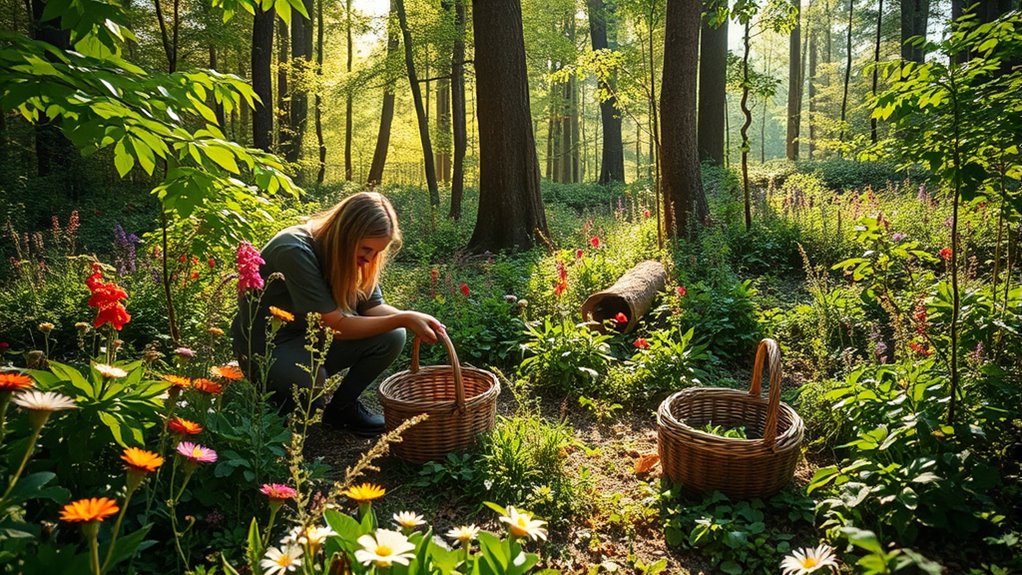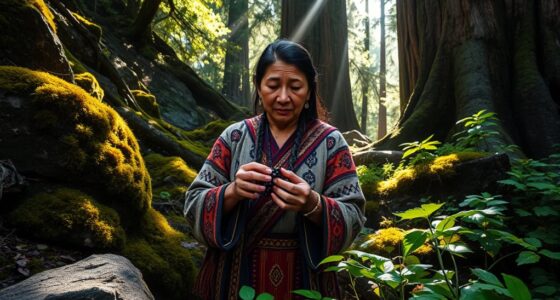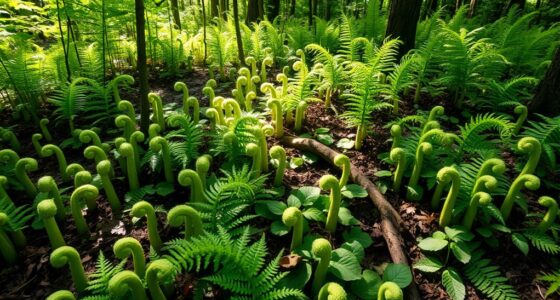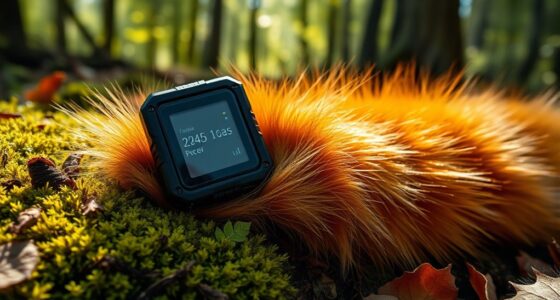When harvesting plants responsibly, you should plan your outing to minimize environmental impact and stick to designated trails to prevent habitat disturbance. Pick only what’s needed and avoid overharvesting, respecting plant growth cycles and local regulations. Use gentle techniques to prevent damage and leave the habitat as you found it. Share your knowledge and promote conservation to help protect native plants. If you want to learn more about practicing sustainable foraging, keep exploring these guiding principles.
Key Takeaways
- Plan harvests carefully, select only necessary parts, and harvest at peak growth to prevent overharvesting and support plant health.
- Stay on established trails, use gentle techniques, and leave natural features undisturbed to minimize habitat impact.
- Respect plant life cycles and avoid harvesting outside optimal seasons to ensure sustainable populations.
- Follow local laws and obtain permits, especially in protected areas, to promote conservation and regulatory compliance.
- Share responsible foraging practices, educate others, and support efforts that preserve native ecosystems and biodiversity.
Plan Your Harvest to Minimize Impact
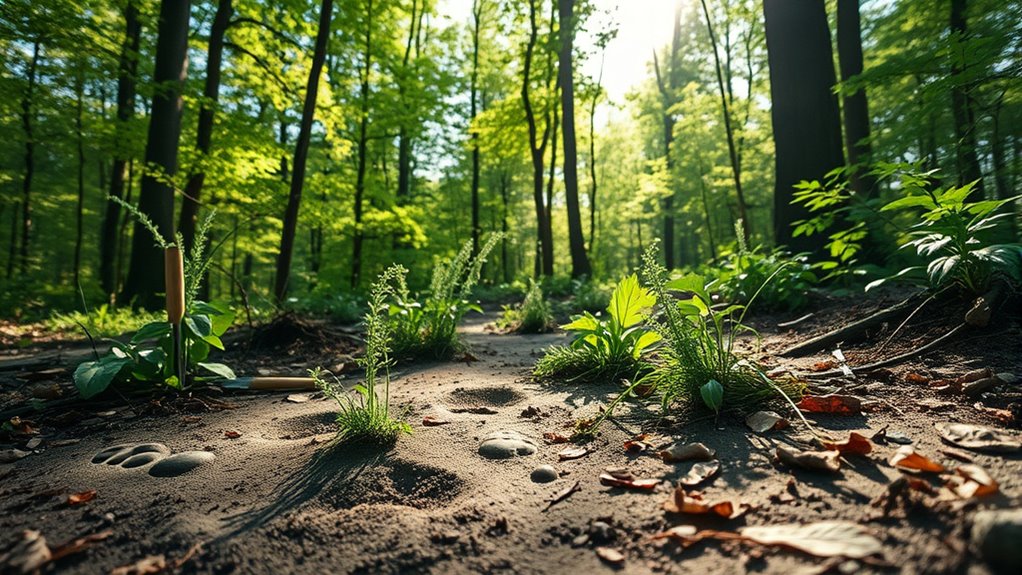
To minimize your impact on the environment, it’s important to plan your harvest carefully before heading into the field. Consider the best harvest timing to avoid disrupting plant growth or damaging nearby wildlife. Picking at the right time ensures you harvest mature plants without overharvesting, which helps maintain the ecosystem’s balance. Tool selection also plays a vital role; choose tools that are appropriate for the plant and gentle in handling, such as scissors or small pruning shears, to reduce unnecessary damage. Avoid heavy or invasive equipment that can trample soil or harm surrounding vegetation. Proper tool selection and features can help you handle plants carefully and reduce environmental disturbance. By thoughtfully timing your harvest and selecting suitable tools, you protect the plant populations and keep the environment healthy for future growth.
Respect Plant Populations and Growth Cycles

Understanding and respecting plant populations and their growth cycles is essential for sustainable harvesting. You should observe the size and density of a plant population before collecting any plants to avoid overharvesting. Recognize that each species has specific growth cycles, including flowering, seed production, and dormancy periods. Harvest during the appropriate phase to ensure plants can reproduce and regenerate. Avoid removing plants outside their peak growth times, as this can weaken the overall population. Keep track of seasonal changes and plant responses to environmental conditions. Monitoring plant health and growth patterns helps ensure sustainable practices. By respecting these growth cycles, you help maintain healthy plant populations and promote long-term sustainability. Your mindful approach supports the resilience of ecosystems, ensuring that plant resources remain available for future harvests.
Use Sustainable Harvesting Techniques
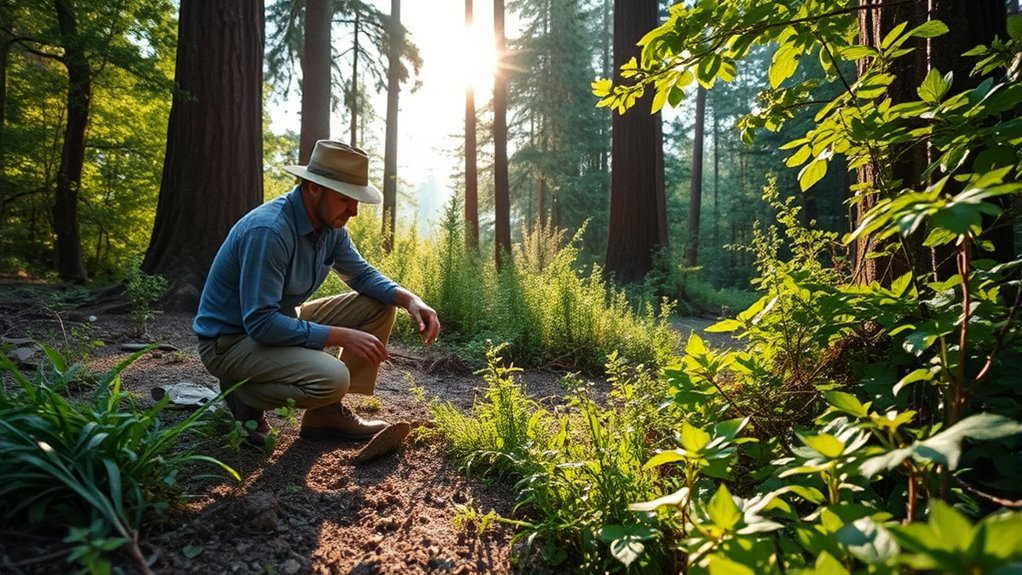
Using sustainable harvesting techniques guarantees that you collect plants in a way that supports their continued growth and health. Embracing wildcrafting ethics means prioritizing the well-being of plants and their ecosystems over immediate gain. Practice foraging mindfulness by selecting only what you need and avoiding overharvesting. Use tools carefully to minimize damage to the roots and surrounding vegetation, ensuring the plant can regenerate. Harvest at appropriate times in the plant’s growth cycle to prevent harming reproduction. Respect the environment by leaving no trace of your activity, and avoid disturbing wildlife or fragile habitats. By adhering to these principles, you help preserve plant populations and maintain ecosystem balance, allowing future foragers and the environment to thrive together. Fostering active listening and empathy during foraging can also enhance awareness of ecological impacts and encourage responsible harvesting habits.
Leave the Habitat Unaltered
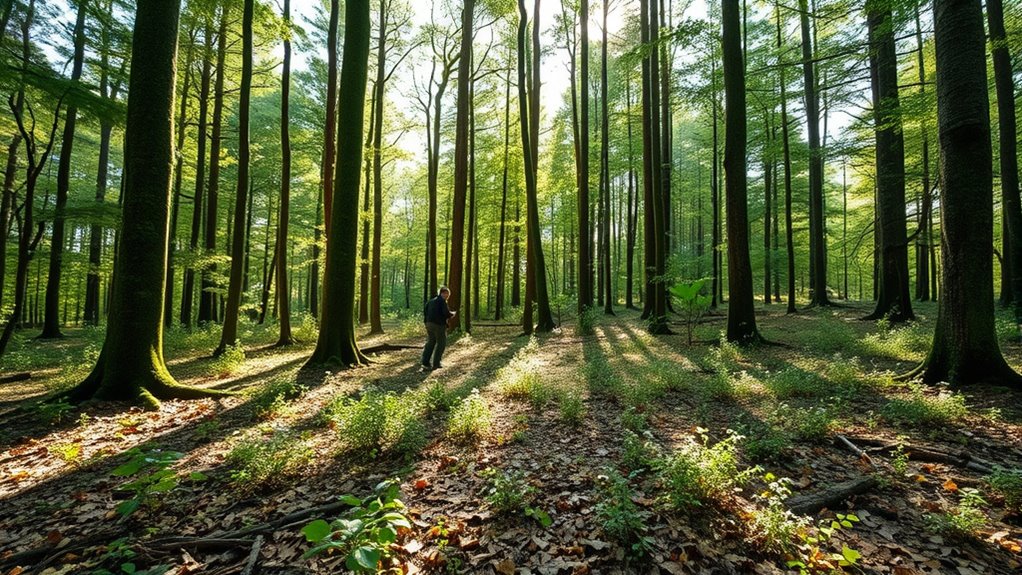
When practicing sustainable harvesting, it’s important to guarantee your activities leave the environment unchanged. Focus on habitat preservation by avoiding unnecessary disturbance to the surrounding area. Stay on established paths to minimize soil compaction and prevent trampling of plants. Be mindful of plant integrity—do not pull or uproot plants unless necessary, and always harvest in a way that preserves their structure. Avoid cutting or damaging leaves, stems, or roots that aren’t intended for collection. Leave the natural features of the habitat untouched, including rocks, logs, and soil. By doing so, you help maintain the ecosystem’s balance and ensure that the habitat remains healthy for future growth. Incorporating mindful practices into your harvesting routine fosters a respectful relationship with the environment and encourages sustainable use. Respecting the environment in this way allows you to harvest responsibly without leaving a lasting impact.
Avoid Overharvesting and Take Only What You Need
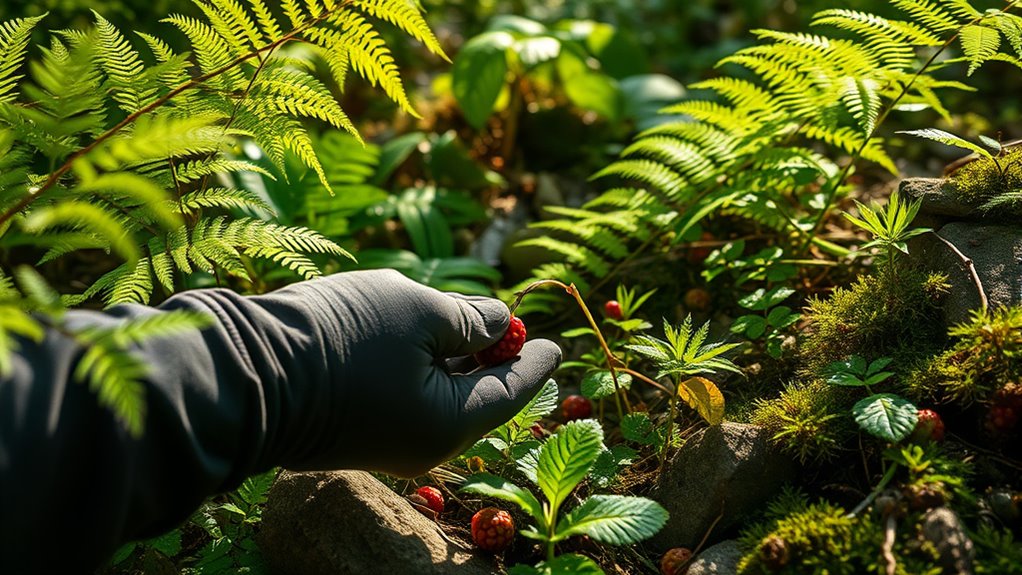
When harvesting plants, you should practice selective picking to avoid damaging the entire population. Assess whether a plant is ready for harvest and respect its natural lifecycle to guarantee it can continue thriving. By taking only what you need, you help preserve the ecosystem for future harvesters and the plants themselves.
Selective Picking Practices
To preserve plant populations and guarantee sustainable harvesting, it’s essential to practice selective picking and only take what you need. This reduces wildlife disturbance, which can occur when frequent human activity displaces animals and disrupts their habitats. By carefully choosing what to harvest, you minimize soil compaction, helping maintain soil health and plant root systems. Avoid removing entire plants or overharvesting from a single area, as this can lead to soil erosion and habitat degradation. Instead, harvest only mature parts and leave enough behind for plant regeneration. Gentle handling and minimal disturbance help assure the ecosystem remains balanced. Remember, your goal is to enjoy the plants without harming their environment, supporting healthy populations for future harvests. Utilizing sustainable practices ensures long-term plant health and ecosystem stability.
Assessing Plant Readiness
Before harvesting, carefully assess whether the plant is truly ready to be picked by checking its appearance, size, and overall health. Look for signs of plant maturity, such as color, firmness, and the development of key features. Seasonal timing also plays a vital role; harvest when the plant is naturally at peak maturity, aligning with its growth cycle. Avoid taking from plants that are still developing or just beginning to flower, as this can hinder future growth. Overharvesting stresses the plant and disrupts the ecosystem. Take only what you need, ensuring the plant has enough remaining to continue thriving. Regularly monitoring plant development helps prevent overharvesting and supports sustainable harvesting practices. By being attentive to these indicators, you help preserve plant populations and respect the environment.
Respecting Plant Lifecycles
Respecting plant lifecycles means understanding that every plant has a natural growth pattern, which guides when and how much you should harvest. By observing pollination cycles, you can identify the ideal time to gather without disrupting reproductive processes. Taking too much during seed dispersal can prevent plants from regenerating naturally, so it’s essential to harvest only what you need. Avoid overharvesting by leaving enough flowers and seeds for the plant to reproduce and support local ecosystems. Remember, plants depend on these cycles for survival, and your mindful harvesting helps maintain healthy populations. By respecting these natural rhythms, you ensure plants thrive for future harvests and contribute to a balanced environment. Your careful approach supports both the plant’s lifecycle and its broader ecological role.
Leave No Trace of Your Presence
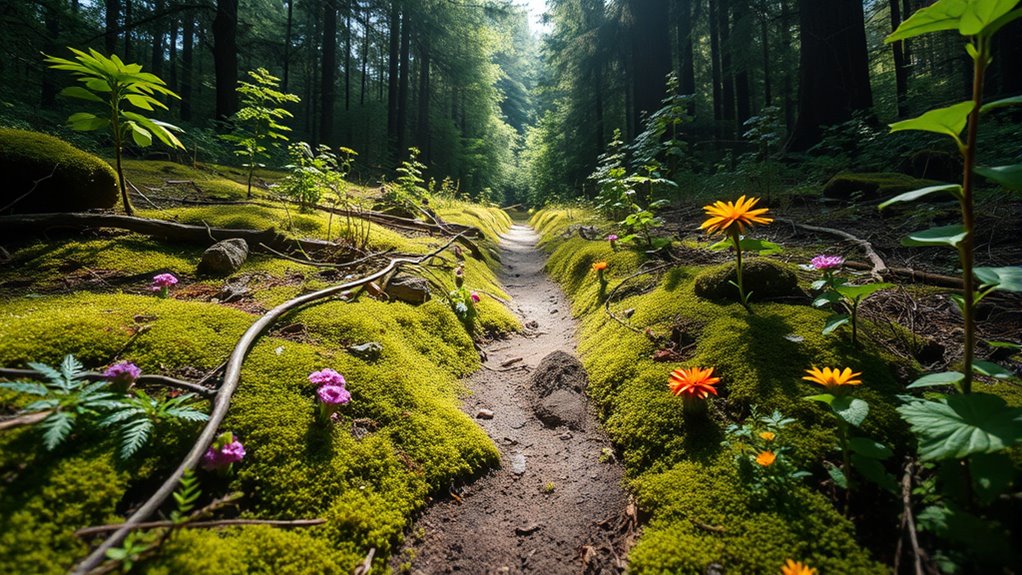
When harvesting plants in the wild, it’s essential to leave no trace of your presence to protect the environment and guarantee future foragers can enjoy the same experience. Be mindful of wildlife habitat; avoid trampling or disturbing animals’ nesting sites. Stick to established trails whenever possible to minimize soil disturbance and prevent creating new paths that can erode or damage plant roots. When collecting, use gentle techniques that leave the surrounding area intact, such as cutting plants carefully rather than pulling them out. Pack out all trash, including plant debris, to keep the area pristine. Your goal is to leave the area just as you found it, ensuring the ecosystem remains healthy and vibrant for generations to come. Understanding industry trends can also help in adopting sustainable harvesting practices that support conservation efforts.
Educate and Advocate for Responsible Foraging
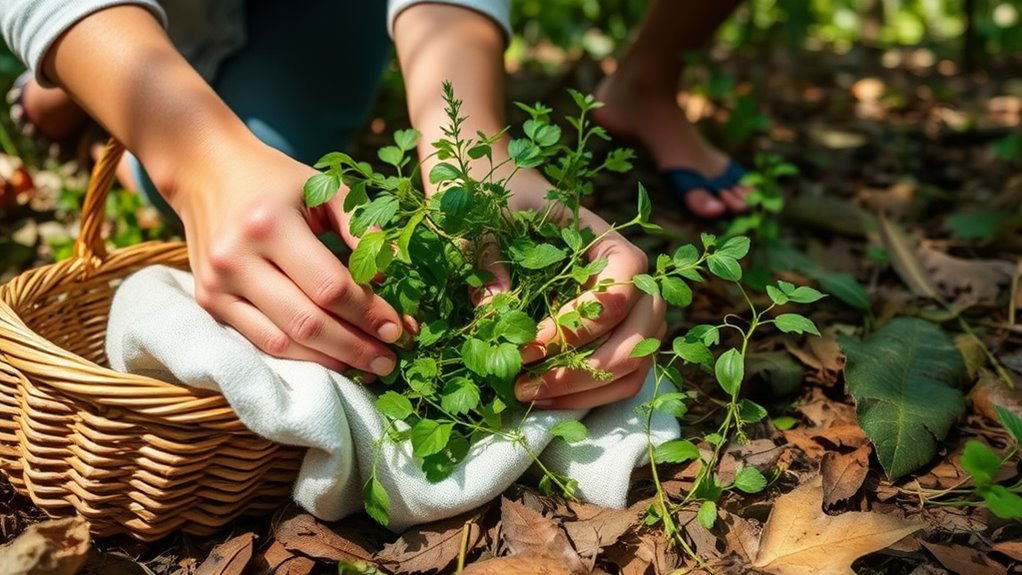
You can make a real difference by sharing responsible foraging tips and encouraging others to follow local regulations. Educating your community helps safeguard plant populations and preserves natural habitats for future harvesters. When you advocate for conservation, you ensure sustainable foraging practices that benefit everyone. Incorporating leave-no-trace principles into your foraging routine can further minimize environmental impact and promote ecological balance.
Respect Local Regulations
Understanding and following local regulations is essential for responsible foraging. Always research the rules in your area before harvesting plants. Local regulations often specify which species can be collected, the quantity allowed, and protected areas where harvesting is prohibited. Some regions require harvesting permits, which ensure sustainable practices and protect ecosystems. By obtaining the necessary permits, you demonstrate respect for local laws and support conservation efforts. Ignoring regulations can lead to fines, environmental harm, or the loss of access to foraging areas. Educating yourself about these rules helps you forage responsibly and ethically. Remember, your goal is to minimize impact and support the health of native plant populations, so stay informed and comply with all local regulations and permit requirements. Additionally, understanding the specific Watering Techniques for your plants can help ensure their health and sustainability during foraging or cultivation.
Share Ethical Foraging Tips
Sharing ethical foraging tips helps guarantee that responsible practices become second nature. By educating others, you reduce wildlife disturbance and minimize trail erosion. Encourage foragers to stay on established paths to protect fragile terrain and prevent habitat disruption. Avoid overharvesting by taking only what’s needed, ensuring plant populations remain healthy. Respect wildlife and other visitors by keeping noise levels down and refraining from disturbing animals. Use the table below to understand the core principles:
| Principle | Why It Matters |
|---|---|
| Stay on designated trails | Prevents trail erosion and habitat damage |
| Harvest sustainably | Protects plant populations for future harvests |
| Minimize disturbance | Preserves wildlife and maintains ecosystem health |
Additionally, incorporating natural materials and thoughtful decor can enhance your environment while maintaining sustainability.
Promote Conservation Awareness
Have you ever considered how educating others about responsible foraging can make a lasting impact? Promoting conservation awareness helps protect plant populations and honors their cultural significance and medicinal uses. When you share knowledge about sustainable harvesting, you encourage respect for ecosystems and future foragers. You can:
- Explain the importance of preserving rare or endangered plants
- Highlight the cultural significance of traditional harvesting practices
- Discuss how responsible foraging supports medicinal uses without overharvesting
- Advocate for Leave-No-Trace principles to minimize environmental impact
Frequently Asked Questions
How Can I Identify Sustainable Harvesting Locations?
To identify sustainable harvesting locations, you should look for areas that support wildlife corridors and prioritize soil preservation. Avoid overharvested spots and choose places with healthy plant populations. Look for signs of minimal human impact, such as natural plant diversity and stable soil. By respecting these signs, you help maintain ecosystem balance, ensuring the environment remains resilient and productive for future harvests and wildlife.
What Tools Minimize Habitat Disturbance During Harvesting?
Think of your tools as gentle brushes that paint without disturbing the canvas. To minimize habitat disturbance during harvesting, you should choose tools that reduce plant impact, like lightweight pruners or hand-held cutters. These allow precise removal without trampling or damaging surrounding vegetation. Careful tool selection helps preserve the ecosystem’s balance, ensuring your harvest leaves minimal trace and supports the health of the habitat for future growth and biodiversity.
How Do Seasonal Changes Affect Harvest Timing?
You should consider seasonal changes because they directly impact harvest timing. During a seasonal bloom, plants are at their peak, making harvesting more effective and sustainable. Conversely, during plant dormancy, it’s best to wait, as plants are less resilient and more vulnerable to damage. Monitoring these seasonal shifts helps you harvest responsibly, ensuring plant health and long-term growth while minimizing habitat disturbance.
Are There Legal Restrictions on Plant Foraging?
Imagine walking through a thriving forest, knowing your choices shape its future. You should consider legal considerations and practice ethical foraging, respecting local laws and protected species. Laws serve as guardians, safeguarding nature’s delicate balance, so always research regulations before harvesting plants. By following these guidelines, you become a steward rather than a destroyer, ensuring your foraging remains sustainable and respectful—honoring the forest’s silent symphony for generations to come.
How Can I Teach Others About Leave-No-Trace Practices?
You can teach others about Leave-No-Trace practices by sharing the importance of ethical foraging and plant conservation. Encourage them to stay on established paths, avoid overharvesting, and respect plant habitats. Show how responsible harvesting supports healthy ecosystems and ensures future growth. Lead by example, and explain how small actions, like packing out waste and minimizing disturbance, help safeguard nature for everyone. Your efforts make a real difference in sustainable plant harvesting.
Conclusion
By following these leave-no-trace principles, you can guarantee your foraging leaves only footprints, not scars. Planning your harvest, respecting nature’s rhythms, and practicing sustainable techniques help keep plant populations healthy and thriving. Remember, you’re part of a delicate web—tread lightly so future foragers can enjoy the bounty too. When you leave no trace, you’re fundamentally passing the torch gently, keeping the wilderness wild and wonderful for generations to come.

